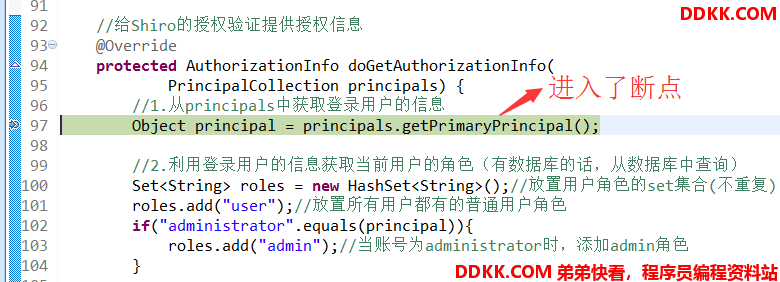注:该系列所有测试均在之前创建的Shiro3的Web工程的基础上。在使用Shiro框架进行授权或者权限管理时,可以利用Shiro框架的缓存特性来提高系统的性能。那么如何来实现Shiro的缓存效果呢?
Shiro中提供了一个CacheManagerAware接口,实现此接口的类都可以进行缓存的一些基础操作。同理也即是说Realm实现了CacheManagerAware接口就可以操作缓存。
当我们的Realm实现了CacheManagerAware接口或继承了实现CacheManagerAware接口的父类的时候,在Shiro内部有组件(DefaultSecurityManager)会自动检测相应的对象(如Realm)是否实现了CacheManagerAware并自动注入相应的CacheManager。
Shiro提供了一个叫CachingRealm的Realm类,它实现了CacheManagerAware接口,所以该Realm提供了缓存的一些基础实现;
那么我们自己创建的,继承AuthorizingRealm类的自定义Realm其实是可以直接操作缓存的,因为自定义Realm继承的AuthorizingRealm类继承了AuthenticatingRealm类,而AuthenticatingRealm类继承了CachingRealm类:

正如上面所说,CachingRealm类实现了CacheManagerAware接口,可以操作缓存:

所以说我们的Realm是有缓存的。
下面我们通过一个授权操作来看一下在Realm缓存的效果。
首先回顾一下名为“Shiro3”的Web工程中的“ShiroRealm”类:
package com.test.shiro.realms;
import java.util.HashMap;
import java.util.HashSet;
import java.util.Iterator;
import java.util.Map;
import java.util.Set;
import org.apache.shiro.authc.AuthenticationException;
import org.apache.shiro.authc.AuthenticationInfo;
import org.apache.shiro.authc.AuthenticationToken;
import org.apache.shiro.authc.LockedAccountException;
import org.apache.shiro.authc.SimpleAuthenticationInfo;
import org.apache.shiro.authc.UnknownAccountException;
import org.apache.shiro.authc.UsernamePasswordToken;
import org.apache.shiro.authz.AuthorizationInfo;
import org.apache.shiro.authz.SimpleAuthorizationInfo;
import org.apache.shiro.crypto.hash.SimpleHash;
import org.apache.shiro.realm.AuthorizingRealm;
import org.apache.shiro.subject.PrincipalCollection;
import org.apache.shiro.util.ByteSource;
import com.test.shiro.po.User;
public class ShiroRealm extends AuthorizingRealm{
private static Map<String,User> userMap = new HashMap<String,User>();
static{
//使用Map模拟数据库获取User表信息
userMap.put("administrator", new User("administrator","5703a57069fce1f17882d283132229e0",false));//密码明文:aaa123
userMap.put("jack", new User("jack","43e66616f8730a08e4bf1663301327b1",false));//密码明文:aaa123
userMap.put("tom", new User("tom","3abee8ced79e15b9b7ddd43b95f02f95",false));//密码明文:bbb321
userMap.put("jean", new User("jean","1a287acb0d87baded1e79f4b4c0d4f3e",true));//密码明文:ccc213
}
@Override
protected AuthenticationInfo doGetAuthenticationInfo(
AuthenticationToken token) throws AuthenticationException {
System.out.println("[ShiroRealm]");
//1.把AuthenticationToken转换为UsernamePasswordToken
UsernamePasswordToken userToken = (UsernamePasswordToken) token;
//2.从UsernamePasswordToken中获取username
String username = userToken.getUsername();
//3.调用数据库的方法,从数据库中查询Username对应的用户记录
System.out.println("从数据看中获取UserName为"+username+"所对应的信息。");
//Map模拟数据库取数据
User u = userMap.get(username);
//4.若用户不行存在,可以抛出UnknownAccountException
if(u==null){
throw new UnknownAccountException("用户不存在");
}
//5.若用户被锁定,可以抛出LockedAccountException
if(u.isLocked()){
throw new LockedAccountException("用户被锁定");
}
//7.根据用户的情况,来构建AuthenticationInfo对象,通常使用的实现类为SimpleAuthenticationInfo
//以下信息是从数据库中获取的
//1)principal:认证的实体信息,可以是username,也可以是数据库表对应的用户的实体对象
Object principal = u.getUsername();
//2)credentials:密码
Object credentials = u.getPassword();
//3)realmName:当前realm对象的name,调用父类的getName()方法即可
String realmName = getName();
//4)credentialsSalt盐值
ByteSource credentialsSalt = ByteSource.Util.bytes(principal);//使用账号作为盐值
SimpleAuthenticationInfo info = null; //new SimpleAuthenticationInfo(principal,credentials,realmName);
info = new SimpleAuthenticationInfo(principal, credentials, credentialsSalt, realmName);
return info;
}
//给Shiro的授权验证提供授权信息
@Override
protected AuthorizationInfo doGetAuthorizationInfo(
PrincipalCollection principals) {
//1.从principals中获取登录用户的信息
Object principal = principals.getPrimaryPrincipal();
//2.利用登录用户的信息获取当前用户的角色(有数据库的话,从数据库中查询)
Set<String> roles = new HashSet<String>();//放置用户角色的set集合(不重复)
roles.add("user");//放置所有用户都有的普通用户角色
if("administrator".equals(principal)){
roles.add("admin");//当账号为administrator时,添加admin角色
}
//3.创建SimpleAuthorizationInfo,并设置其roles属性
SimpleAuthorizationInfo info = new SimpleAuthorizationInfo(roles);
//4.返回SimpleAuthorizationInfo对象
return info;
}
}
然后我们在doGetAuthorizationInfo方法的“Object principal = principals.getPrimaryPrincipal();”处打断点,然后运行Web程序,在登录界面登录账号为“jack”的账户:

然后进入了断点:

这说明是第一次登录,此时系统还没有授权信息的缓存,会调用doGetAuthorizationInfo的方法获取用户的授权信息。然后再一次访问页面之后,因为上一次缓存了用户的授权信息,所以就不会再进入doGetAuthorizationInfo方法的断点了。
而前面说到,Shiro内部组件DefaultSecurityManager会自动检测相应的对象(如Realm)是否实现了CacheManagerAware并自动注入相应的CacheManager。那么也就是说如果不注入CacheManager就无法实现缓存的效果,所以在Web工程的Spring配置文件application.xml中是配置了CacheManager的:
<!--1. 配置 SecurityManager-->
<bean id="securityManager" class="org.apache.shiro.web.mgt.DefaultWebSecurityManager">
<property name="cacheManager" ref="cacheManager"/>
<property name="authenticator" ref="authenticator"/>
<property name="realms">
<list>
<ref bean="shiroRealm"/>
<ref bean="secordRealm"/>
</list>
</property>
</bean>
<!--
2. 配置 CacheManager.
2.1 需要加入 ehcache 的 jar 包及配置文件.
-->
<bean id="cacheManager" class="org.apache.shiro.cache.ehcache.EhCacheManager">
<property name="cacheManagerConfigFile" value="classpath:ehcache.xml"/>
</bean>
如果我们将
实际上在配置Realm的时候,还可以设置Realm缓存的一些属性:

而同意我们可以在ehcache配置文件ehcache.xml中可以设置这些缓存属性:
<ehcache>
<diskStore path="java.io.tmpdir"/>
<!-- 授权的时候使用的缓存策略 -->
<cache name="authorizationCache"
eternal="false"
timeToIdleSeconds="3600"
timeToLiveSeconds="0"
overflowToDisk="false"
statistics="true">
</cache>
<!-- 认证的时候使用的缓存策略 -->
<cache name="authenticationCache"
eternal="false"
timeToIdleSeconds="3600"
timeToLiveSeconds="0"
overflowToDisk="false"
statistics="true">
</cache>
<ehcache>
而Session也可以使用缓存,实现方式大致相同,其也是通过实现CacheManagerAware接口或继承实现CacheManagerAware接口的父类来获取缓存的。如SecurityManager实现了SessionSecurityManager,其会判断SessionManager是否实现了CacheManagerAware接口,如果实现了会把CacheManager设置给它。SessionManager也会判断相应的SessionDAO(如继承 自CachingSessionDAO)是否实现了CacheManagerAware,如果实现了会把CacheManager设置给它。设置了缓存的SessionManager,查询时会先查缓存,如果找不到才查数据库。
实际开发时,通常会使用Redis来作为Session的缓存。